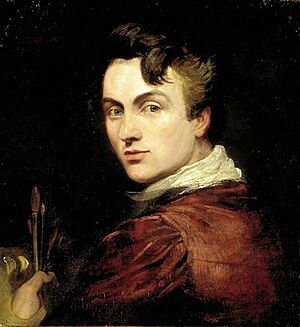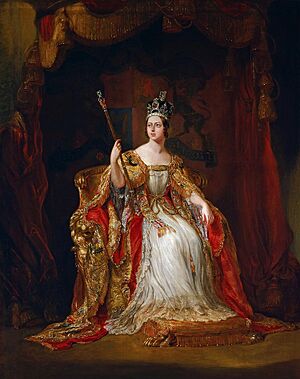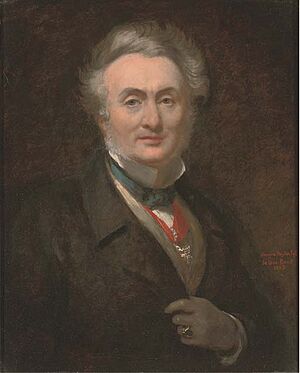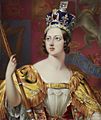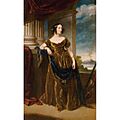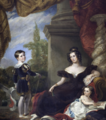George Hayter facts for kids
Quick facts for kids
George Hayter
|
|
|---|---|

Self Portrait from 1843 (Private collection)
|
|
| Born |
George Hayter
17 December 1792 St. James's, London, England
|
| Died | 18 January 1871 (aged 78) Marylebone, London, England
|
| Nationality | English |
| Education | Royal Academy Schools |
| Known for | Painter |
|
Notable work
|
The Trial of Queen Caroline in the House of Lords 1820 [1] The First Meeting of the Reformed House of Parliament 1833 [2] State Portrait of HM Queen Victoria 1838 [3] The Coronation of HM Queen Victoria 1838 [4] The Marriage of Queen Victoria 1840 [5] The Christening of the Prince of Wales 1842 [6] |
| Movement | Romanticism |
| Awards | Knight Bachelor, Knight of the Lion and the Sun of Persia, Member of the Academies of St. Luke (Rome), Bologna, Parma, Florence and Venice |
| Patron(s) | Queen Victoria, King Leopold I of the Belgians, 6th Duke of Bedford, 6th Duke of Devonshire |
Sir George Hayter (born December 17, 1792 – died January 18, 1871) was a famous English painter. He was known for his detailed portraits and very large paintings. These big artworks sometimes included hundreds of individual portraits! Queen Victoria really liked his work. She made him her official painter, called the Principal Painter in Ordinary, and gave him a special award, making him a knight, in 1841.
Contents
Early Life and Art Training
George Hayter was the son of Charles Hayter, who was also a painter. His father specialized in tiny portraits called miniatures. He was also a popular drawing teacher. Charles Hayter taught about perspective, which is how artists create depth and distance in their drawings.
George first learned from his father. In 1808, he joined the Royal Academy Schools to study art. But that same year, he had a disagreement about his studies. He ran away to sea and became a Midshipman in the Royal Navy. His father helped him leave the Navy. They agreed that George would help his father while continuing his own art studies.
George had five children. In 1815, he became the official painter of miniatures and portraits for Princess Charlotte. He also won an award for his historical painting called The Prophet Ezra.
Studying Art in Italy
George Hayter's friend, John Russell, 6th Duke of Bedford, encouraged him to travel. So, in 1816, George went to Italy to study art. There, he met a famous sculptor named Canova. George spent time in Canova's studio and even painted his portrait. He learned a lot about the classical art style, which focuses on balance and perfect forms. People believe he also learned sculpture from Canova.
Canova was a leader at the Accademia di San Luca, a top art school in Rome. He helped George become the youngest member ever of this important Academy.
Painting Important Moments
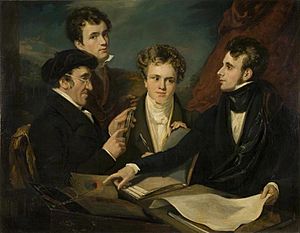
When George returned to London in 1818, he became a successful portrait and history painter. History paintings show important events or stories. Some people found him a bit too proud, but he was friends with many important families. Because of his personal life, he was never chosen to be a member of the Royal Academy.
The 1820s were a very busy and creative time for Hayter. He painted The Trial of Queen Caroline in 1820. This huge painting showed King George IV trying to divorce Queen Caroline in the House of Lords. It was a very dramatic event, and Hayter captured it well. He also painted The Trial of William, Lord Russell in 1825, which showed a historical trial from 1683.
Travels to Europe
In 1826, Hayter moved to Italy again. He painted The Banditti of Kurdistan Assisting Georgians in Carrying off Circassian Women. This painting showed that he was learning from French Romantic artists. These artists liked exciting and exotic subjects.
By 1828, he was in Paris, France. He painted portraits of many English people living there. His style was similar to popular French portrait painters of that time.
Working for the Royal Family
In 1831, Hayter came back to England. He had a big idea: to paint the first meeting of the British Parliament after a major change called the Reform Bill. This painting, called Moving the Address to the Crown on the Opening of the First Reformed Parliament in the Old House of Commons, 5 February 1833, took him ten years to finish! He painted almost 400 individual portraits for it. Hayter strongly supported this reform, so he worked on the painting out of passion, without a guarantee of being paid. This artwork is one of the last pictures of the old House of Commons before it burned down in 1834. The government finally bought it in 1854.
Hayter had painted the young Princess Victoria in 1832. So, it was no surprise when she became Queen and chose him as her 'Portrait and Historical Painter'. When the previous Principal Painter died in 1841, Hayter was given that important job. This made some artists at the Royal Academy a bit upset, as this role usually went to their President. In 1842, George Hayter was made a knight.
He painted several important royal events, including:
- Queen Victoria's coronation in 1838
- Her marriage in 1840
- The Christening of the Prince of Wales in 1843
He also painted many royal portraits, including his most famous one, the State Portrait of Queen Victoria. He made several copies of this portrait with help from his son, Angelo. These copies were sent as gifts to other countries. However, Hayter's time as the Queen's main painter didn't last long. Prince Albert, the Queen's husband, preferred German painters.
Many of Hayter's important royal paintings are still part of the Royal Collection. You can see some of them at Buckingham Palace.
Later Life and Artworks
As he got older, in his fifties, Hayter faced health issues and money problems. He sold some of his art in 1845. He planned to move back to Europe, but he was badly injured in a train accident that same year. He married twice more after his first wife, Sarah, died in 1844.
By the mid-1840s, Hayter's portrait style was seen as a bit old-fashioned. He changed his history paintings to fit the tastes of the time. He painted several large religious scenes, like Bishop Latimer Preaching at Paul's Cross and The Martyrdom of Bishops Ridley and Latimer. He also painted scenes from the Bible, such as The Angels Ministering to Christ (1849) and Joseph Interpreting the Baker's Dream (1854).
Besides large paintings, he also created beautiful landscape watercolours, especially of Italian views. He made etchings (a type of printmaking) and even designed sculptures.
Sir George Hayter passed away on January 18, 1871, at his home in London. He was buried in St Marylebone cemetery.
His younger brother, John Hayter, was also an artist. He was known for drawing portraits using chalks and crayons. Their younger sister, Anne, painted miniatures. George Hayter's great-great-grandson was the French painter and writer, Jean René Bazaine.
Images for kids
-
Detail from State Portrait of Queen Victoria 1837
-
The Christening of the Prince of Wales in St. George's Chapel, Windsor 25 Jan 1842
-
The Trial of Queen Caroline in the House of Lords 1820 (188 portraits), completed 1823
-
Robert Jenkinson, 2nd Earl of Liverpool and Prime Minister, 1823 (for Trial of Queen Caroline picture)
-
General Thomas Graham, 1st Baron Lynedoch 1823
-
Duchess of Kent (mother of Queen Victoria), 1835
-
Antonio Canova painted in 1817
-
Queen Louise of Belgium, Windsor 1837
-
Edwin Landseer drawn in 1825
-
Saith Satoor and Ali Hassan Bey, 1831. Saith Satoor was the protégé of Prince Abbas Mirza, Crown Prince of Persia
-
Sofia Kiselyova, daughter of Count Stanislav Potocki 1831
-
The Hon. Mrs. Caroline Norton, society beauty and author, 1832
-
Charles Grey, 2nd Earl Grey Prime Minister 1830–1834
-
Lord Melbourne Prime Minister 1834, 1835–1841
-
John Spencer, 3rd Earl Spencer (1782–1845)
-
Lady Louisa Stuart at the age of ninety-three, sketch in oils
-
Admiral Sir Edward Codrington 1835
-
The Duke of Wellington (1839), for the House of Commons picture
-
Rt Hon John Johnson, Lord Mayor of London 1845
-
Hemsted Park, three studies with trees and storm clouds, 1856
See also
- List of British painters
- Henry Collen


